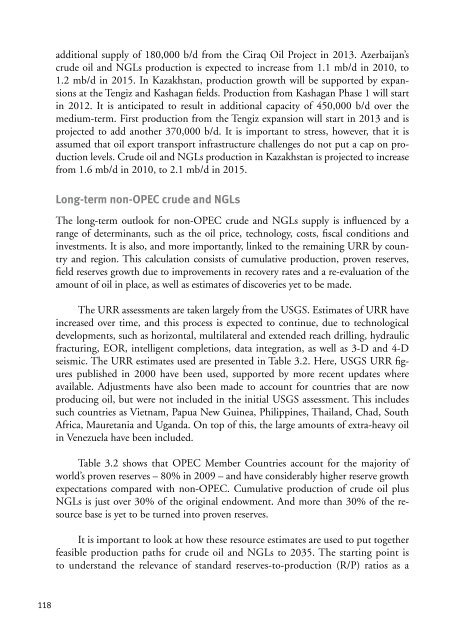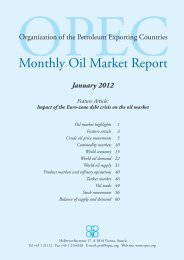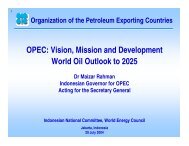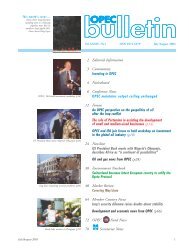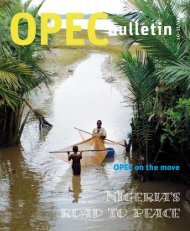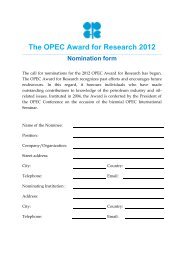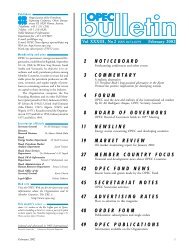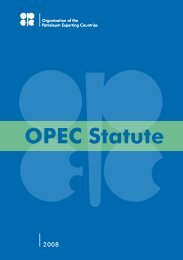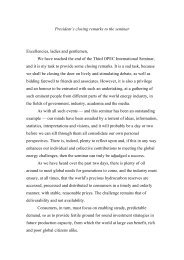Section One
Section One
Section One
Create successful ePaper yourself
Turn your PDF publications into a flip-book with our unique Google optimized e-Paper software.
118<br />
additional supply of 180,000 b/d from the Ciraq Oil Project in 2013. Azerbaijan’s<br />
crude oil and NGLs production is expected to increase from 1.1 mb/d in 2010, to<br />
1.2 mb/d in 2015. In Kazakhstan, production growth will be supported by expansions<br />
at the Tengiz and Kashagan fields. Production from Kashagan Phase 1 will start<br />
in 2012. It is anticipated to result in additional capacity of 450,000 b/d over the<br />
medium-term. First production from the Tengiz expansion will start in 2013 and is<br />
projected to add another 370,000 b/d. It is important to stress, however, that it is<br />
assumed that oil export transport infrastructure challenges do not put a cap on production<br />
levels. Crude oil and NGLs production in Kazakhstan is projected to increase<br />
from 1.6 mb/d in 2010, to 2.1 mb/d in 2015.<br />
Long-term non-OPEC crude and NGLs<br />
The long-term outlook for non-OPEC crude and NGLs supply is influenced by a<br />
range of determinants, such as the oil price, technology, costs, fiscal conditions and<br />
investments. It is also, and more importantly, linked to the remaining URR by country<br />
and region. This calculation consists of cumulative production, proven reserves,<br />
field reserves growth due to improvements in recovery rates and a re-evaluation of the<br />
amount of oil in place, as well as estimates of discoveries yet to be made.<br />
The URR assessments are taken largely from the USGS. Estimates of URR have<br />
increased over time, and this process is expected to continue, due to technological<br />
developments, such as horizontal, multilateral and extended reach drilling, hydraulic<br />
fracturing, EOR, intelligent completions, data integration, as well as 3-D and 4-D<br />
seismic. The URR estimates used are presented in Table 3.2. Here, USGS URR figures<br />
published in 2000 have been used, supported by more recent updates where<br />
available. Adjustments have also been made to account for countries that are now<br />
producing oil, but were not included in the initial USGS assessment. This includes<br />
such countries as Vietnam, Papua New Guinea, Philippines, Thailand, Chad, South<br />
Africa, Mauretania and Uganda. On top of this, the large amounts of extra-heavy oil<br />
in Venezuela have been included.<br />
Table 3.2 shows that OPEC Member Countries account for the majority of<br />
world’s proven reserves – 80% in 2009 – and have considerably higher reserve growth<br />
expectations compared with non-OPEC. Cumulative production of crude oil plus<br />
NGLs is just over 30% of the original endowment. And more than 30% of the resource<br />
base is yet to be turned into proven reserves.<br />
It is important to look at how these resource estimates are used to put together<br />
feasible production paths for crude oil and NGLs to 2035. The starting point is<br />
to understand the relevance of standard reserves-to-production (R/P) ratios as a


